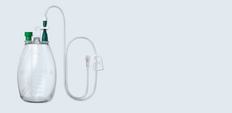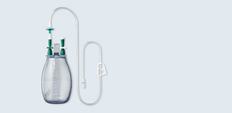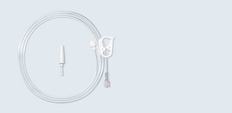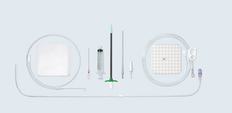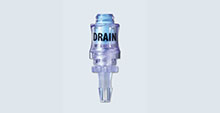ASEPT® Drainage
Recurring pleural effusions or ascites can be treated on an outpatient basis using the ASEPT® system. Cardinal symptoms, such as dyspnoea, already improve during drainage. A spontaneous pleurodesis arises in 59 % of the cases within one month. (Warren et al., European Journal of Cardio-thoracic Surgery 33 (2008) 89-94)
A tunnelled permanent drainage catheter is implanted in the pleural cavity (pleural effusion) or in the peritoneal cavity (ascites) by means of Seldinger technique. After completion of this surgical intervention, the patient is able to return home. The drainage is carried out there every 1 – 2 days in accordance with instructions provided by the physician. Thus punctures become dispensable.
General Benfits
Improved quality of life
The direct symptoms, e.g. dyspnoea, already improve during the drainage. A spontaneous pleurodesis occurs within one month in 59% of the cases. (Warren et al., European Journal of Cardio-thoracic Surgery 33 (2008) 89-94)
Drainage using the ASEPT® system is almost painless, when compared with other forms of treatment, e.g. chemical pleurodesis.
Outpatient drainage
Thanks to the outpatient drainage time-consuming and exhausting punctures in hospital resp. in a medical practice become dispensable. The drainage can be carried out by the patient himself, relatives or a nursing care service. They will be trained by examined nursing staff from pfmmedical. Drainage bottles are sent directly to the patient.
Minimally invasive
The catheter is inserted in the pleural or peritoneal cavity by means of the Seldinger technique – this minimises the risk of internal organs being injured. The intervention which is carried out under local anaesthetic can take place whether as an inpatient or as an outpatient.
Prevention of revolving door effects
Constant connection with a drainage bag may lead to a dislocation of the implant. A new system and an inpatient stay would be the result. Through an intermittent drainage by means of vacuum the patient has the greatest possible mobility and therefore quality of life. It is recommended to regularly drain with suction in order to prevent possible (protein) accumulations within the catheter and valve.
Safe
The treatment has a low infection rate. On the one hand the tunnelled application of the catheter provides an effective infection barrier, on the other hand the drainage bottles which are under negative pressure prevent contaminated fluids from penetrating the effusion space.
Different strengths of suction
For the outpatient drainage two alternative bottle systems are available. According to the indication as well as individual preferences the therapy can be done either by means of high vacuum (ASEPT® Drainage Kit) or low vacuum respectively gravity drainage (ASEPT® Drainage Kit L).
ASEPT® Drainage Kit
ASEPT® Drainage Kit Downloads The ASEPT® Drainage Kit (600 ml & 1,000 ml) enables pleural effusions and ascites be drained on an outpatient basis. The kit includes all of the consumables which are required to ensure a hygienic drainage. Benefits Safely pre-evacuated The bottles have been pre-evacuated and are under negative pressure. The effusion fluid is simply suctioned by it being connected to the ASEPT® catheter. A vacuum indicator (please…
ASEPT® Drainage Kit L
ASEPT® Drainage Kit L Downloads The ASEPT® Drainage Kits L allow the out-patient drainage of pleural effusions and ascites. They are available in the sizes 600 ml and 1,000 ml have a low-vacuum which allows a gentle and nearly painless drainage. Apart from that the system can be switched to a gravity application with just one grip. The ASEPT® Drainage Kits L in sizes 600 ml and 1,000 ml are equipped with a disk check valve. This prevents air from…
ASEPT® Drainage Line Set
ASEPT® Drainage Line Set Downloads The ASEPT® drainage line set can be used to connect the ASEPT® drainage catheter to a wall suction, for example. A drainage tube adapeter is included. Manufacturer pfm medical mepro gmbh Am Söterberg 4 66620 Nonnweiler-Otzenhausen, Germany Ordering Information REF PU P09080006 10 Downloads ASEPT® Drainage System | Product Brochure (PB3700EN) ASEPT® Drainage System | Information Brochure
ASEPT® Peritoneal Drainage System
ASEPT® Peritoneal Drainage System Downloads The ASEPT® Peritoneal Drainage System includes all of the components which are required for a tunnelled insertion of the ASEPT® permanent drainage catheter using the Seldinger technique. Benefits Safety valve The ASEPT® valve closes automatically, is easy to clean and connects the catheter with the drainage bottle in an especially hygienic way. No end caps or fixations are required. The valve even works…
ASEPT® Pleural Drainage System
ASEPT® Pleural Drainage System Downloads The ASEPT® Pleural Drainage System includes all of the components which are required for a tunnelled insertion of the ASEPT® permanent drainage catheter using the Seldinger technique. Benefits Safety valve The ASEPT® valve closes automatically, is easy to clean and connects the catheter with the drainage bottle in an especially hygienic way. No end caps or fixations are required. The valve even works…
ASEPT® Replacement Valve
ASEPT® Replacement Valve Downloads A damaged valve can be easily replaced with an ASEPT® replacement valve. Manufacturer pfm medical mepro gmbh Am Söterberg 4 66620 Nonnweiler-Otzenhausen, Germany Ordering Information REF PU P09080005 5 Downloads ASEPT® Drainage System | Product Brochure (PB3700EN) ASEPT® Drainage System | Information Brochure

